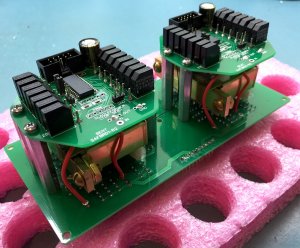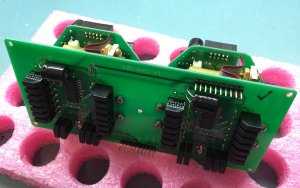All,
In the LIO Tubestage thread here on the VR forum, I was asked for some info on the LIO AVC (Autoformer Volume Control),
a pic, etc. So here goes:
 Top view of LIO AVC Module.
Top view of LIO AVC Module.So what is it? Let's start from our website description:
This is a premium volume control option that is an alternative to the LIO RVC (or RVC + Tubestage combo, as it takes the place of the LIO Tubestage module). The heart of this module is the amazing top of-the-line autoformer made by Dave Slagle of www.intactaudio.com. It is 100% passive and sonically transparent with the entire signal path consisting of only pure magnet wire and high quality switching elements made by Pickering in England. Full remote control of volume up and down and also right/left balance and mute function.
Notable is the small 1db step size – unheard of for an autoformer or transformer volume control.
Features
* Volume range is -54db on up to +7db
* 1dB step size
* Attenuation range: -54db to +7db
* Full dual mono switching allows for L/R balance control with no additional circuitry
* Balance adjustments in 1dB steps via LIO remote control handset, or LIO’s tablet/phone interface.
LIO's AVC option is one module that I cannot take any credit for. It was the creation of John Chapman (Bent Audio) and David Slagle of Intact Audio. John was offering Slagleformers with custom relay control (I assume this is the "auto" part) under his Bent Audio TAP System - which has a very loyal following. John and I thought it would be a great option to offer LIO owners.
So what is an autoformer, and why use it (instead of a resistor volume control)? David Slagle's site has a good FAQ on this:
http://www.intactaudio.com/atten_FAQ.htmlFrom that link:
Q - Why use an autoformer volume control? I've been happy with a good quality potentiometer.
A - The simple answer is that most people find that the autoformer volume control sounds significantly better than even the best potentiometer or stepped attenuator. And it's not a subtle difference; most people report that the autoformer has such an open, effortless sound that they would not consider going back to a resistive device.
Exactly why they sound better is still under debate, but one theory is that it's because an autoformer doesn't attenuate by wasting energy. A fairly good analogy can be made to the transmission in a car. If you need to drive at a slow steady speed which method would you choose: (1) leave the transmission in high gear and apply the brakes to keep from going too fast, or (2) downshift into a lower gear that will allow the car to go the desired speed with minimum effort?
An autoformer is essentially an electronic gearbox that operates without wasting significant energy. Potentiometers and stepped attenuators adjust the signal level by literally turning the excess signal into heat. On the other hand, when an autoformer is adjusted for low volume level it actually makes things easier for the source, much like a low gear makes things easy for your car engine.
 Bottom/Side view of LIO AVC Module.So how do they compare, sonically?
Bottom/Side view of LIO AVC Module.So how do they compare, sonically? Srajan @ 6moons will be reviewing a LIO, and I will be sending him BOTH an RVC + TUBESTAGE, and an AVC module. I'm confident that he'll be able to pin down what he is hearing in the context of the system he will be reviewing the LIO in. I wrote to him some comments about it, and he mentioned them in his preview:
"Which is better - Tubestage + RVC, or AVC? Actually, I don't see one as better than the other. They simply have different flavours. For super transparency and neutrality, the AVC is hard to beat. For more meat on the bones of tonal richness, density and a greater sense of space albeit at the expense of 'some transparency and speed,' the RVC plus tube stage are the way to go. Some customers in fact might want to have both and change things up every now and then; or as they change their system (e.g. different modules will work best with different speakers or headphones)."
I will briefly add the following impressions, based on more time listening and comparing since I wrote the above to Srajan:RVC (standalone with no Tubestage module following it): The RVC module on its own is quite neutral sounding. It is more transparent sounding than a potentiometer, has better channel matching, is right on par with Goldpoint and DACT stepped attenuators that I've used in the past (but
RVC offers 64 remote volume controlled steps, and a balance control since it is a dual-mono design - so we can offset the L and R channels when you use the balance control on the remote - without adding any additional circuitry).
RVC + Tubestage: When you add the LIO Tubestage (which follows the RVC in the signal path), the sound becomes more open (closer to the added sense of openness to the sound when using the AVC). The soundstage expands more in the 3-dimensions, the bass has more weight, the midrange becomes richer (but not overly dense / this is NOT an overly tooooby kinda sound), there is added texture. NOTE - this is also dependent on the tubes you are using. My comments above are with the stock JJ E88CC tubes, as that is what comes with the Tubestage module. With some of those nice NOS tubes (I will be starting a LIO tube rolling thread soon), it gets even better! You will LOVE the tubestage if you like to tinker with the sound, and in general if you prefer more midrange magic over precision and transparency.
With the AVC (vs. the RVC on its own): The sound is more open, the bass also has more weight, the is better speed and attack, more top end extension and detail (but the midrange is not a rich as with the RVC + Tubestage above - which is something that you may or may not want), and overall I'd say you get the best precision / transparency with AVC. It is neutral, and is an evn cleaner window into the music compared to RVC on its own.
So is adding the Tubestage to the RVC, or is replacing the RVC with the AVC worth the $$$ ? Try it - with a 30-day return policy if you don't find either to be worth the asking price. I am very confident that with adding Tubestage to RVC or going with AVC instead of RVC, you will hear more difference than you will by swapping interconnects (unless you just had some poorly made cables or bad connections to begin with). With LIO, you can try for yourself at any time. You don't have to ship your LIO to me for the update - you can quickly and easily install it yourself, go back and forth, and decide for yourself. Then YOU know for sure what sound best to you, in your system and room, playing YOUR music.

Hopefully this post / thread will be helpful in providing info about what the AVC is, and maybe will help you decide if it is right for you.
Vinnie